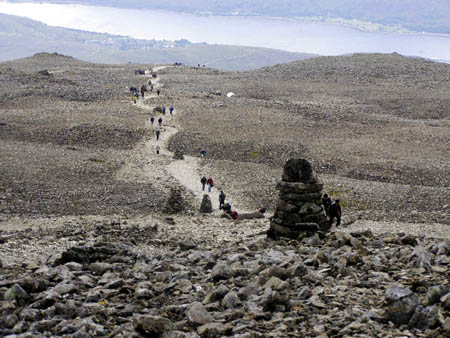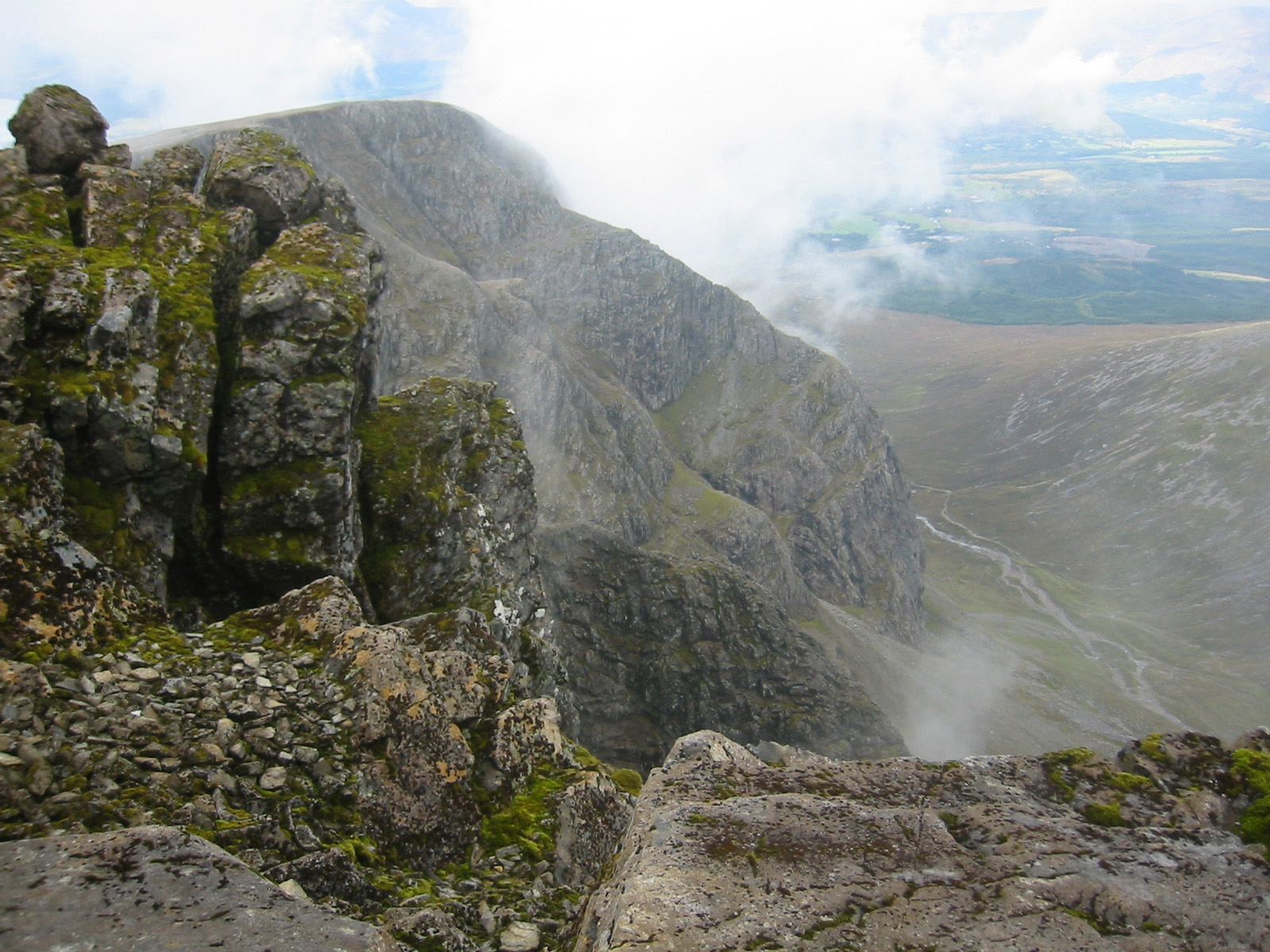
The path to the summit, showing cairns which have been left
Walkers on the summit of Britain’s highest mountain are being asked not to build any more cairns on it.
The plea follows five years’ work by volunteers from the John Muir Trust, owners of Ben Nevis, involving the removal of more than 120 piles of rocks which the trust said were unsightly.
But about 20 cairns have been left in place near the ‘tourist’ path to the 1,344m (4,409ft) summit – with a warning to inexperienced hillwalkers that these are not adequate to guide the way safely to the top of the mountain, which has precipitous gullies on three sides.
The completion of the clearing of the many cairns littering the summit follows a campaign which caused controversy among many walkers. A large number of the cairns were placed as memorials to loved ones. Plaques were removed and placed, where possible, in a memorial garden in Glen Nevis.
A spokesman for the JMT said: “Cairns and memorials on Scotland’s hills are a source of intense controversy amongst walkers and conservationists.
“The debate rages between those who think that they add to the experience of a good walk and others who are convinced that any man-made structure is an unnecessary intrusion into a remote landscape. The John Muir Trust has removed these cairns in line with its wild land policy to ‘remove redundant non-archaeological structures’.”
The trust said the cairns were being used as rubbish bins and their proliferation was giving people a false sense of security.
Sandy Maxwell, the trust’s conservation activities co-ordinator, said: “These randomly laid cairns could easily deceive walkers into thinking they were following a path.
“On Ben Nevis, like all mountains in Scotland, the weather can change rapidly so it is essential to be prepared to navigate yourself.
“These cairns should not be used as a primary feature for navigation,” he said. “There is no substitute for a map and compass, and if you are not confident with your navigation skills, do not attempt to walk to the summit of Ben Nevis in poor weather. The cairns are spaced too widely apart to be followed in poor visibility.”

Ben Nevis's northern gullies
The JMT said the cairns had often been started simply as a means of covering rubbish left by walkers. They had been added to by further additions of stones and rubbish stuffed into nooks and crannies. During the work to remove the ubiquitous piles, trust volunteers had uncovered a piano and a wheelchair bearing a sticker from a van-hire company in Skipton, North Yorkshire.
Hundreds of sacks of litter had also been removed from the ben during the clean-up.
The JMT has left a few cairns in place for both pragmatic and historic reasons, it says.
They were built as part of the pony track that wound up to a Victorian observatory built on the summit in 1883.
The observatory, funded by private donors, provided constant meteorological data for twenty years before being abandoned in 1904.
One important cairn which has been left in place is the world-famous peace cairn. The Fort William-Dudley Memorial and Peace Cairn was built on top of Britain’s highest mountain on VJ Day in 1945 and dedicated to universal world peace.
Mr Maxwell made a final plea to walkers: “Ben Nevis is no ordinary mountain and we are committed to protecting its unique history together with its rugged landscape.
“Now that the main work of clearing unwanted cairns is over, I urge visitors to Britain highest mountain to leave its summit as you find it.”
The John Muir Trust, named after the Scottish-born Victorian founder of the national park movement, also owns land on the Red Cuillin in Skye, Schiehallion, Quinag and Sandwood Bay.
See also
Clean-up team finds wheelchair buried on Ben Nevis
Nevis: no more memorials, please
Nevis cleanup strikes strange note
Bill Morris
06 December 2010Having just climbed Ben Nevis two days ago in deep snow, heavy cloud and unusually low temperatures, the row of cairns leading to the summit were a very welcome and reasuring endorsement of our own bearings and calculations.
Whilst I uphold the Trusts decision to de-clutter the plateau, these primary cairns are a lifesaver on a popular recreational walkers mountain.
Best Regards
Bill Morris
'To the Highlands for Heroes'
Help for Heroes charity 100 mile trek.
www.bmycharity.com/highlands4heroes
Crashmatt
10 February 2011No-one who in not able to navigate using map and compass should be on a mountain top. Cairns are unnecessary and unsightly.
My Homepage
20 June 2012... [Trackback]...
[...] Informations on that Topic: grough.co.uk/magazine/2008/11/13/nevis-cairns-job-done-now-leave-ben-in-peace-pleads-trust [...]...